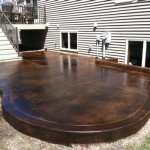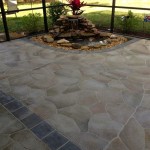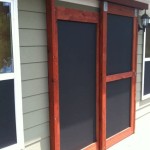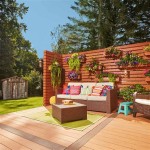Creating The Perfect Patio Bistro Setup: Guidelines
Transforming an outdoor space into an inviting bistro area can significantly enhance the enjoyment of a home. A well-designed patio bistro provides a dedicated space for relaxation, dining, and socializing. Strategic planning and careful selection of furniture and accessories are critical to creating an aesthetically pleasing and functional outdoor oasis. This article outlines key guidelines for establishing the perfect patio bistro setup.
Space Assessment and Planning
Before embarking on the design process, conducting a thorough assessment of the available space is paramount. This involves measuring the dimensions of the patio and considering any existing architectural features, such as walls, doors, or landscaping elements. Understanding the space constraints will inform decisions regarding the size and configuration of the bistro furniture.
Consider the primary purpose of the bistro area. Will it be primarily used for dining, casual lounging, or a combination of both? The intended use will influence the selection of furniture and accessories. For example, a dining-focused bistro will require a table and chairs, while a lounge-oriented space might benefit from comfortable seating arrangements, such as cushioned chairs or a small outdoor sofa.
Developing a spatial plan is a crucial step. This involves sketching a layout of the patio area, indicating the placement of furniture, plants, and other decorative elements. A well-defined plan ensures that the bistro area is functional and aesthetically balanced. Consider the flow of traffic and ensure that there is adequate space for movement around the furniture.
Take into account the existing landscape. Mature trees can provide shade and privacy, enhancing the ambiance of the bistro area. Existing flowerbeds or shrubbery can be incorporated into the design, adding visual interest and creating a cohesive outdoor space. If the patio lacks natural shade, consider adding a pergola or umbrella to provide respite from the sun.
Sun exposure is another critical factor to consider. Observe the direction and intensity of sunlight throughout the day. Position the bistro table and seating in a location that offers comfortable shade during peak sunlight hours. If the patio is exposed to strong winds, consider adding windbreaks, such as screens or hedges, to create a more sheltered environment.
Furniture Selection and Arrangement
The selection of furniture is a key aspect of creating the perfect patio bistro setup. Choose furniture that is durable, weather-resistant, and aesthetically pleasing. Outdoor furniture is typically constructed from materials such as aluminum, teak, wrought iron, or synthetic wicker. Each material has its own advantages and disadvantages in terms of durability, maintenance, and style.
Aluminum furniture is lightweight, rust-resistant, and relatively easy to maintain. Teak furniture is known for its natural beauty and durability. Wrought iron furniture is sturdy and provides a classic, elegant look. Synthetic wicker furniture is weatherproof and comes in a variety of styles and colors.
The size and style of the bistro table should be proportionate to the size of the patio area. A small, round table is ideal for intimate gatherings, while a larger rectangular table can accommodate more guests. Consider the height of the table and chairs to ensure comfortable dining.
Select chairs that complement the style of the table and provide adequate support. Armchairs offer additional comfort and are ideal for lounging. Consider adding cushions or pads to the chairs to enhance comfort and visual appeal. Choose cushions and pads that are made from weather-resistant materials, such as Sunbrella fabric.
The arrangement of the furniture should promote conversation and create a sense of intimacy. Position the chairs around the table in a way that encourages interaction. Consider adding a small side table or coffee table to provide a place to set drinks or snacks. Ensure that there is enough space between the furniture to allow for easy movement.
Incorporate storage solutions to keep the bistro area tidy and organized. An outdoor storage bench or cabinet can be used to store cushions, blankets, and other accessories. This helps to prevent clutter and keeps the patio looking neat and inviting.
Ambiance and Decorative Elements
Creating the right ambiance is essential for maximizing the enjoyment of the patio bistro area. Lighting plays a crucial role in setting the mood. String lights, lanterns, and candles can create a warm and inviting atmosphere. Consider using solar-powered lights to reduce energy consumption.
Plants add life and color to the patio area. Choose plants that are suited to the climate and growing conditions. Container gardening is a great way to add greenery to a patio. Arrange the plants in pots of varying sizes and heights to create visual interest. Consider adding herbs or vegetables to the container garden to add functionality.
Rugs can define the seating area and add warmth and texture to the patio. Choose an outdoor rug that is made from weather-resistant materials, such as polypropylene or nylon. Patterns and colors can add visual interest and complement the style of the furniture.
Accessories such as throw pillows, blankets, and decorative objects can personalize the patio area. Choose accessories that reflect personal style and interests. Consider adding a small water feature, such as a fountain, to create a relaxing and soothing environment. Wind chimes can also add a gentle and calming sound.
Sound systems can enhance the ambiance of the bistro area. Consider installing outdoor speakers to play music or podcasts. Choose speakers that are weather-resistant and provide high-quality sound. Control the volume to avoid disturbing neighbors.
Privacy screens can provide a sense of seclusion and block unwanted views. Consider using lattice panels, bamboo screens, or tall plants to create a privacy barrier. This can help to create a more intimate and relaxing atmosphere.
Careful coordination of color is vital. Choose a color palette that is harmonious and reflects personal style. Natural tones, such as greens, browns, and blues, can create a calming and inviting atmosphere. Bright pops of color can add energy and visual interest.
Maintenance is an ongoing consideration. Regular cleaning and upkeep will help to keep the patio bistro area looking its best. Sweep the patio regularly to remove dirt and debris. Clean the furniture with soap and water as needed. Protect the furniture from the elements during the off-season by covering it or storing it indoors.
By following these guidelines, it is possible to create a patio bistro setup that is both functional and aesthetically pleasing. The result will be a space that enhances the enjoyment of the outdoor environment.

French Bistro Inspired Patio Dining Jenna Sue Design

How To Design And Create A Cozy Bistro Dining Area In Your Garden

A Planning Guide For The Perfect Outdoor Kitchen This Old House

Key Measurements For Designing Your Perfect Patio

Create An Outdoor Dining Area On A Budget

Key Measurements For Planning Your Outdoor Furniture Layout

How To Choose The Perfect Size Patio Dining Set For Your Outdoor Space

How To Choose The Perfect Patio Set Dot Furniture S Backyard Guide D O T Limited

Your Guide To Creating The Perfect Serene Outdoor Spaces For Summer Shiplap And Ss

How To Design And Create A Cozy Bistro Dining Area In Your Garden
Related Posts








